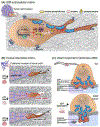Fueling Cell Invasion through Extracellular Matrix
- PMID: 33549396
- PMCID: PMC8122022
- DOI: 10.1016/j.tcb.2021.01.006
Fueling Cell Invasion through Extracellular Matrix
Abstract
Cell invasion through extracellular matrix (ECM) has pivotal roles in cell dispersal during development, immune cell trafficking, and cancer metastasis. Many elegant studies have revealed the specialized cellular protrusions, proteases, and distinct modes of migration invasive cells use to overcome ECM barriers. Less clear, however, is how invasive cells provide energy, specifically ATP, to power the energetically demanding membrane trafficking, F-actin polymerization, and actomyosin machinery that mediate break down, remodeling, and movement through ECMs. Here, we provide an overview of the challenges of examining ATP generation and delivery within invading cells and how recent studies using diverse invasion models, experimental approaches, and energy biosensors are revealing that energy metabolism is an integral component of cell invasive behavior that is dynamically tuned to overcome the ECM environment.
Keywords: Cell invasion; adaptive ATP metabolism; extracellular matrix; glycolysis; mitochondrial localization; oxidative phosphorylation.
Copyright © 2021 Elsevier Ltd. All rights reserved.
Conflict of interest statement
Declaration of Interests The authors declare no competing interests.
Figures



References
-
- McLennan R, McKinney MC, Teddy JM, Morrison JA, Kasemeier-Kulesa JC, Ridenour DA, et al. Neural crest cells bulldoze through the microenvironment using Aquaporin 1 to stabilize filopodia. Development. 2020. January 9;147(1). - PubMed
Publication types
MeSH terms
Substances
Grants and funding
LinkOut - more resources
Full Text Sources
Other Literature Sources

